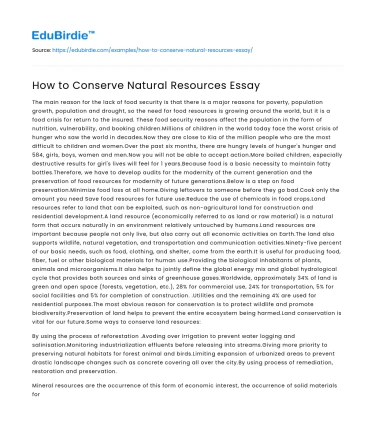Introduction
The conservation of natural resources is a critical issue facing humanity today, as the relentless exploitation of the Earth's resources poses severe threats to environmental sustainability and human survival. Natural resources, including water, minerals, forests, and fossil fuels, are vital for the sustenance of life and the functioning of global economies. However, the rapid depletion and degradation of these resources necessitate urgent action to ensure their availability for future generations. This essay explores various strategies for conserving natural resources, emphasizing the need for sustainable management practices. By examining specific examples, real-life cases, and considering counter-arguments, the discussion aims to provide a comprehensive understanding of resource conservation. This approach not only highlights the importance of preserving natural resources but also addresses the challenges and potential solutions for achieving long-term sustainability.
Integrated Resource Management
Integrated resource management (IRM) is a holistic approach that seeks to balance the use and protection of natural resources, considering ecological, economic, and social factors. By emphasizing the interconnectedness of resource systems, IRM encourages collaborative decision-making and adaptive management practices. A notable example of IRM is the management of water resources in the Murray-Darling Basin in Australia. This region has faced significant challenges due to competing demands from agriculture, industry, and urban areas, leading to over-extraction and environmental degradation. In response, the Australian government implemented the Murray-Darling Basin Plan, which aims to achieve equitable water distribution and sustainable management through stakeholder engagement and scientific research (Grafton et al., 2019). This case demonstrates the potential of IRM to address complex resource management issues by fostering cooperation and adaptive strategies.
Save your time!
We can take care of your essay
- Proper editing and formatting
- Free revision, title page, and bibliography
- Flexible prices and money-back guarantee
While IRM offers significant benefits, critics argue that its implementation can be hindered by institutional barriers and conflicts of interest. For instance, stakeholders with vested interests in resource exploitation may resist collaborative efforts, preferring short-term gains over long-term sustainability. However, addressing these challenges requires robust governance structures that promote transparency, accountability, and stakeholder participation. According to Ostrom (2009), effective resource management necessitates the establishment of clear rules and mechanisms for conflict resolution, enabling stakeholders to align their interests with sustainable outcomes. By overcoming these barriers, IRM can facilitate the conservation of natural resources and enhance resilience to environmental changes.
Technological Innovations in Resource Conservation
Technological advancements play a pivotal role in conserving natural resources by improving efficiency and reducing waste. Innovations such as renewable energy technologies, precision agriculture, and waste recycling systems have the potential to significantly reduce resource consumption and environmental impact. For instance, the widespread adoption of solar and wind energy has contributed to a decline in reliance on fossil fuels, mitigating greenhouse gas emissions and promoting energy security. According to the International Energy Agency (2020), renewable energy accounted for nearly 30% of global electricity generation in 2020, underscoring the transformative impact of technology on resource conservation.
Precision agriculture, which leverages data analytics and automation, offers another promising avenue for conservation. By optimizing water usage, fertilizer application, and pest control, precision agriculture enhances crop yields while minimizing resource inputs and environmental harm. A study by Schimmelpfennig (2016) highlights the potential of precision agriculture to reduce water usage by up to 20%, showcasing its contribution to sustainable resource management. However, the adoption of such technologies can be constrained by high initial costs and limited access to technical expertise, particularly in developing regions. To address these challenges, governments and international organizations must invest in capacity-building and infrastructure development to ensure equitable access to technological innovations.
Community-Based Conservation Initiatives
Community-based conservation initiatives empower local communities to take an active role in managing natural resources, fostering a sense of stewardship and ownership. These initiatives are particularly effective in contexts where traditional governance structures are limited or ineffective. A notable example is the Namibian Community-Based Natural Resource Management (CBNRM) program, which has successfully integrated conservation and rural development goals. By devolving resource management rights to local communities, the CBNRM program has incentivized sustainable practices and generated economic benefits through ecotourism and wildlife management (Naidoo et al., 2016). This approach not only conserves biodiversity but also enhances community livelihoods, demonstrating the potential for synergy between conservation and development.
Nevertheless, community-based conservation faces challenges such as resource conflicts, inadequate funding, and capacity constraints. Critics argue that without sufficient support and coordination, these initiatives may struggle to achieve their objectives. To enhance their effectiveness, it is essential to establish strong partnerships between communities, governments, and non-governmental organizations. Capacity-building efforts, financial support, and technical assistance can empower communities to implement sustainable practices and address resource-related challenges. By fostering collaboration and enhancing local capacity, community-based conservation can serve as a powerful tool for resource management and environmental sustainability.
Conclusion
In conclusion, conserving natural resources is a multifaceted challenge that requires a combination of integrated management approaches, technological innovations, and community-based initiatives. By adopting strategies that balance ecological, economic, and social considerations, it is possible to achieve sustainable resource management and ensure the availability of resources for future generations. While challenges such as institutional barriers, technological constraints, and resource conflicts persist, addressing these issues necessitates collaboration, capacity-building, and robust governance structures. As highlighted by the examples and cases discussed, there is no one-size-fits-all solution to resource conservation. Instead, a diverse array of strategies, tailored to specific contexts and challenges, is essential for promoting sustainability and resilience. Ultimately, the conservation of natural resources is not only a matter of environmental necessity but also a moral imperative, calling for collective action and commitment to safeguarding the planet for present and future generations.






 Stuck on your essay?
Stuck on your essay?

